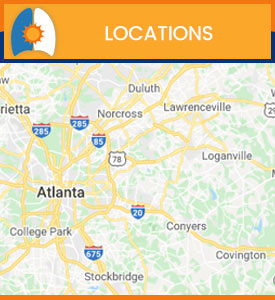Nasal, Sinus and Seasonal Allergy Treatment Questions and Answers
The Allergy & Asthma Center offers expert medical attention by top rated doctors. For more information, please contact us or book an appointment online. We serve patients from Lawrenceville GA, Atlanta GA, Conyers GA, Suwanee GA, Duluth GA, Grayson GA, Decatur GA, Brookhaven GA, Lithonia GA and Covington GA.


Table of Contents:
Rhinitis can be chronic or acute
Are there other types of rhinitis?
How does one make the diagnosis?
What treatment options are available?
One of the most common presentations of allergies in both children and adults involves the nose and eyes. The clinical condition involving nasal symptoms is called “rhinitis” and we call allergic involvement of the eyes “conjunctivitis”. We all know people who suffer from allergic rhinitis, or “hay fever”. You can spot them from across the room- tissue in hand, sneezing, sniffling, blowing their nose, tearing, and rubbing their eyes. If fortunate, these symptoms are but a minor inconvenience, but, if severe, they can significantly affect one’s quality of life.
Allergies involving the nose and eyes are almost always caused by the contact of an offending “allergen” to the mucous membrane lining of the nose or eyes. Constant exposure to allergens can cause daily symptoms, resulting in what your physician would diagnose as “persistent, chronic, or perennial allergic rhinitis”. Allergens responsible for these chronic symptoms may include house dust mites, mold spores, cockroach allergen, feathers, or indoor pets.
Symptoms of allergic rhinitis can also be acute or intermittent, presenting only when one is exposed to a relevant allergen. It is not uncommon for a cat allergic individual to have an acute episode of allergic rhinitis (and even asthma) when they enter into the home where a cat resides. The same might occur when a grass allergic person cuts the grass or enters a barn where they are exposed to hay. Typically, symptoms are short lived in this scenario, but they can be quite severe.
“Seasonal allergic rhinitis”, as its name implies, will manifest itself usually during the pollen seasons, most typically in the spring and fall. Exposure to tree pollens is generally responsible for late winter and springtime symptoms and grass pollens are generally the cause of springtime and early summer symptoms. Flare ups in the fall are typically due to weed pollens and high mold spore exposure. Symptoms of seasonal allergic rhino-conjunctivitis can be quite intense, and can last for weeks to months, if not treated.
There is another common condition that can present with symptoms quite similar to those of allergic rhinitis, but it is really not an allergy at all. This condition is called Vasomotor (VMR) or Non-Allergic (NAR) Rhinitis, and is frequently misdiagnosed as allergies.
VMR presents most commonly in women, with its onset typically in the second or third decade of life. Even though its cause has not been established, the lining cells of the nose and sinuses become hypersensitive to the inhalation of nonspecific irritants. As opposed to the inhalation of allergens resulting in a classic allergic reaction, the inhalation of nonspecific irritants results in the inflammation of the mucous membranes of the upper respiratory anatomy. The airborne irritants most likely to produce symptoms are cigarette smoke, perfumes or colognes, other strong fragrances present in aerosols and cleaning solutions, scented candles, potpourri, new carpets or fabrics, and diesel fumes, to name a few. Symptoms can also result from weather conditions, such as changes in temperature, humidity, or barometric pressure.
Allergic rhinitis is actually one of the easiest diagnoses for an allergist to make. If the medical history suggests allergic rhinitis, the allergist is likely to perform allergy testing in order to confirm the diagnosis, identify the offending allergen(s), and ascertain the severity of the allergy. The preferable testing method by most allergists is skin testing. This method allows the testing of multiple allergens with the results being available immediately. Alternatively, similar results can be obtained through a blood test called RAST or ImmunoCap.
Once the relevant allergens have been identified, a comprehensive treatment plan will be recommended. Treatment options fall into three categories: environmental control, pharmacotherapy, and immunotherapy. One, two, or all three of these options may be recommended, depending on multiple factors such as the severity and chronicity of symptoms, results of past treatment, and the effect that these symptoms have on one’s quality of life.
The concept of environmental control is quite simple: one needs to minimize exposure to allergens to which he/she is sensitive. As simple as this is conceptually, it may be quite difficult, if not impossible, to implement in many cases. The classic case is the patient who is cat-allergic and lives in a home with a cat. Removing the cat from the home can in some cases be curative, but, in reality, there is often great resistance to the recommendation to remove the cat from the home due to the attachment a family develops with a pet, and the resultant emotional issues that can ensue. And, there are allergens which are impossible to totally eliminate from the home such as house dust mites and mold spores.
Fortunately, however, there are effective methods to reduce exposure to these allergens.
In the arena of pharmacotherapy, there are many medicines available which are quite effective in minimizing or eliminating the symptoms of allergic rhinitis. These generally fall into the categories of antihistamines, steroid nasal sprays, and other non-steroidal blockers of inflammation.
As important as environmental control and pharmacotherapy are, neither of these approaches addresses the actual cause of the allergy, i.e., the immune system’s over-response to things (allergens) that it should be able to tolerate without inducing symptoms. The third treatment option, immunotherapy, or desensitization, is the only treatment that addresses the actual cause of the problem.
Once the cause of the rhinitis has been identified, your allergist will recommend a treatment plan designed to minimize or eliminate your rhinitis and/or conjunctivitis symptoms.

Additional Allergy & Asthma Services
▸ Allergy Shots
▸ Allergy Testing
▸ Asthma
▸ Bronchodilators
▸ Drug Allergy
▸ Food Allergy
▸ Insect Allergy
▸ Nasal/Sinus Allergies
▸ Pediatric Allergy
▸ Pediatric Asthma
▸ Skin Allergy
▸ Spring Allergies




